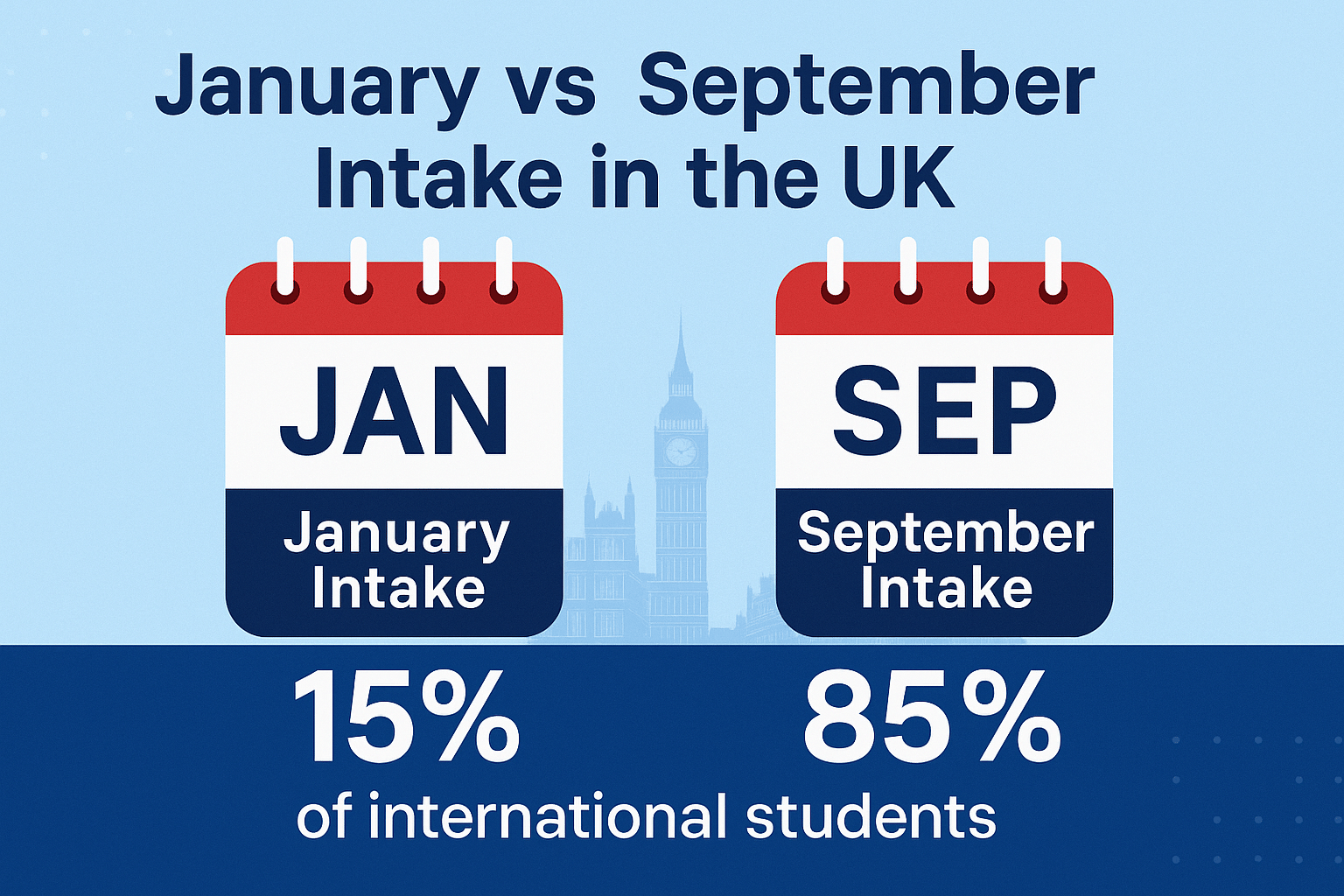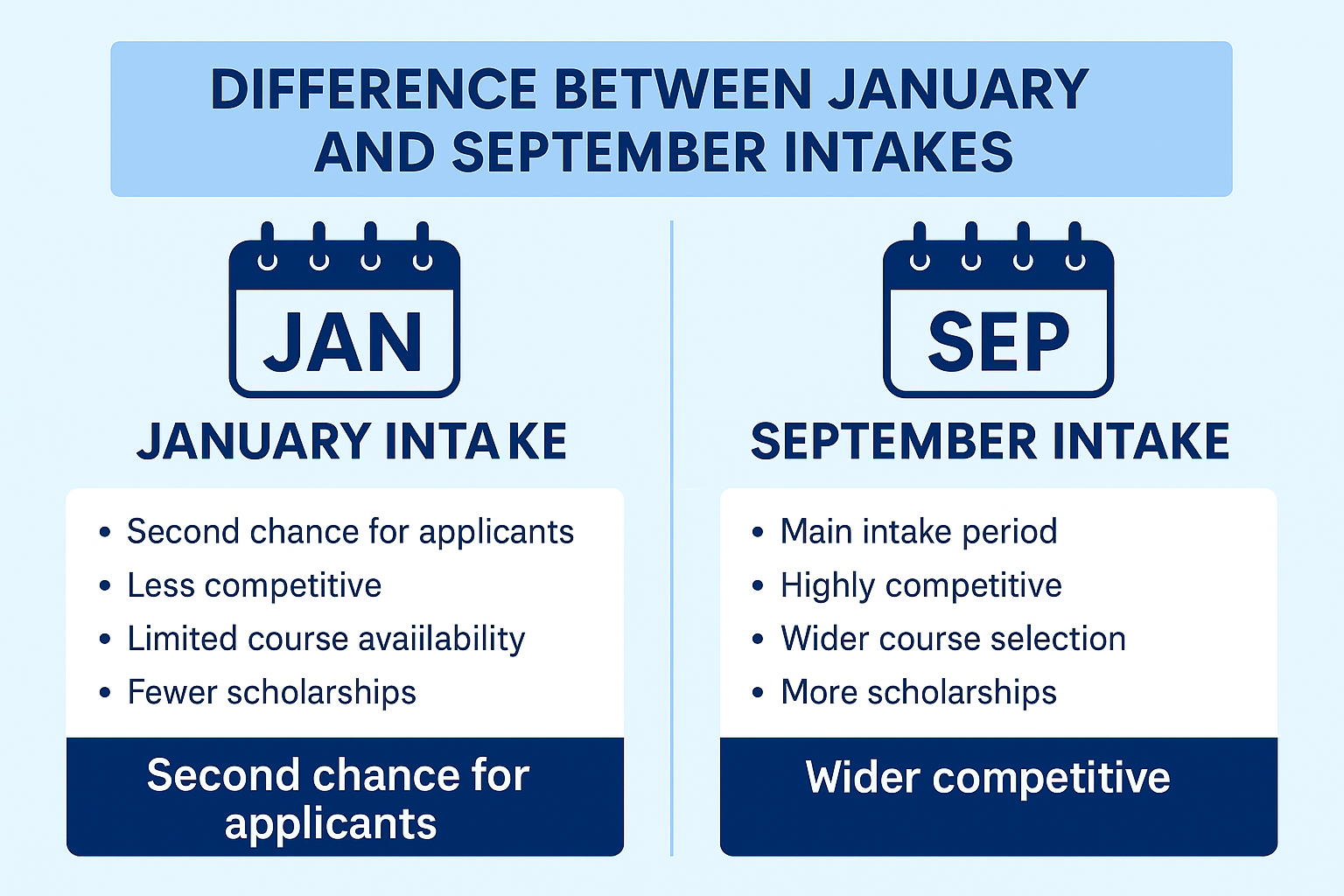Jasmine Grover Content Strategy Manager
Content Strategy Manager | Updated On - Sep 29, 2025
Choosing the right intake for university admission can significantly impact your academic journey and career prospects. In the UK, the two most popular intakes are January and September. According to recent data from UCAS (the Universities and Colleges Admissions Service), over 85% of international students opt for the September intake, while the January intake accounts for only about 15% of admissions. However, the January intake has been steadily growing in popularity, offering more flexibility and opportunities for students worldwide.
Understanding the differences between these two intakes—including application deadlines, course availability, and campus life—can help prospective students make informed decisions tailored to their needs.
Also Read: Study in UK for Indian Students

Difference Between January and Fall Intakes
The UK universities provide 2 major intakes for all international students. The key differences between these two are as follows:
January Intake
The January Intake in UK, also known as the Winter Intake, offers a valuable second chance for students seeking to study in the UK. It is a good opportunity for those who missed the September Intake or need extra time to prepare for the entrance exam.
Key Points about January Intake in UK:
- The January intake is mostly available for postgraduate and research programs. Only about 15–20% of UK universities offer undergraduate courses in January.
- Acts as a backup option for students who missed the September Intake deadlines.
- Less competitive than the September Intake, as fewer students apply.
- Provides extra preparation time for tests, finances, and visa processes.
- Scholarships and courses are fewer in comparison to the September Intake.
- Application deadlines fall between July to November for most universities.
Also Read
Intakes in UKSeptember Intake
The Fall Intake, also known as the Autumn or September Intake, is the primary academic entry point for UK universities.
Key Points about Fall Intake in UK:
- It is the largest intake, with the widest variety of undergraduate and postgraduate programs available.
- Offers more scholarships and funding opportunities compared to the January Intake.
- Highly competitive due to the large number of applicants each year.
- Application deadlines typically fall between September and January, so early preparation is crucial.

Advantages and Disadvantages of Intakes in UK
The key advantages of both January and September intakes in UK are:
| January Vs September Intake: Advantages | ||
|---|---|---|
| Aspect | January Intake | September Intake |
| Course Start | Second chance for those who missed the Fall Intake | Main intake with a large number of participants |
| Competition | Less competition, easier to qualify | More structured and popular, recognised globally |
| Preparation Time | Gets extra time for preparation and arrangement | Longer lead time before courses begin, allowing extra time for preparation, VISA, and finances. |
| Scholarships | January-specific scholarships in some universities, such as Nottingham Trent University, Kingston University, etc. | Widest range of scholarships and funding |
| Networking | Smaller batch, easier to get individual attention | Large cohort, more networking and exposure |
Check Out: Top Master Programs in UK
Disadvantages of January and September Intakes.
In the January Intake, the course availability is limited with fewer opportunities for networking and fewer scholarships, whereas in the Fall Intake, competition is high with strict deadlines.
| January Vs September Intake: Disadvantages | ||
|---|---|---|
| Aspect | January Intake | September Intake |
| Course Availability | Limited courses, mostly postgraduate Example: University of Derby, Edinburgh Napier University |
Wide range of courses, but fills quickly Example: University of Liverpool, Queen Mary University of London. |
| Scholarships | Less funding | Competitive to get a scholarship |
| Visa & CAS | Strict timelines | Need to apply early |
| Campus Life | Small orientation and fewer events | High competition |
| Flexibility | Not all universities offer a January start | Missing deadlines means waiting until January |
Also Read
Scholarships in UKWhich UK Intake Should You Choose?
Deciding between the January Intake and the Fall Intake in the UK is not just about the admission months; it also depends on the academic goals, plans, and readiness. Here are the key aspects to consider when choosing an Intake:
1. Academic Goals and Course Availability
- Check if the program you want to choose is offered in both Intakes.
2. Scholarships and Funding Opportunities
- Fall Intake offers more scholarships in comparison to January Intake.
- January Intake offers fewer funding options, so budget planning becomes important.
3. Visa Timeline
- Fall Intake offers more time for visa processing.
- January Intake offers less time for visa processing.
4. Competition and Admission Chances
- Fall Intake has higher competition but also more seats.
- January Intake has less number of applicants, which makes the admission easy.
5. Student Experience
- Fall intake offers the full UK university experience with larger orientations, student clubs, job fairs, and career events.
- January students may join midway, so orientation is smaller, and networking opportunities may be limited.
6. Career Plans and Graduation Timeline
- Fall students graduate earlier in the year, students starting in September 2025 typically complete a 1-year Master’s by August/September 2026.
- January 2026 intake students finish by December 2026/January 2027.
- This may help them enter the job market sooner.
Also Read
Best Courses to Study in UKUK Universities Offering January 2026 Intake
Here’s a list of some UK universities offering January 2026 intake:
Application Process for January and Fall Intake.
The application process of both intakes slightly differs from each intake:
January Intake
The application process for the January intake in UK is as follows:
- Application Submission: Apply through the university’s official website within the specified dates.
- Documents Required: Academic transcripts, degree certificates, English test scores (IELTS/TOEFL), Statement of Purpose, Letters of Recommendation, and CV.
- Offer Letter: Universities issue conditional or unconditional offers; some may require pre-CAS interviews.
- Visa Processing: After receiving the CAS (Confirmation of Acceptance for Studies), apply for a UK student visa.
- Pre-sessional English: Some universities offer short English courses before the semester, if needed.
September Intake
The Fall Intake is the main intake for most programmes. It usually has a longer timeline and more options. The application process is as follows:
- Applications: Undergraduates apply via UCAS; postgraduates apply directly to universities from September 2025.
- Documents Required: Same documents are required as January Intake: transcripts, English test scores, SOP, LOR, CV.
- Visa Processing: With a longer lead time, students get more time to apply for the UK student visa.
- Pre-sessional English (if required): Many universities provide courses during summer before the semester begins.

Choosing between the January 2026 Intake and the Fall 2026 Intake in the UK mostly depends on the academic goals, financial readiness, and personal timeline. While the Fall Intake offers the most courses, scholarships, and the complete university experience, the January Intake provides flexibility, less competition, and a valuable second chance for those who missed September deadlines.
Also Read
How to apply to UK universities?FAQs
Ques. What is the typical application deadline for January 2026 intake?
Ans. Most universities accept applications for January intake between July to November of the previous year, depending on the program and university.
Ques. Is the January intake in UK less competitive than the September intake?
Ans. Yes, a smaller number of students apply for January, making it relatively less competitive, but course availability and scholarships are limited.



Comments